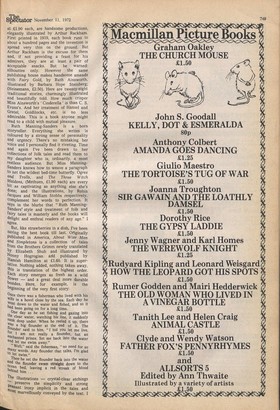Folk and fairy tales
Leon Garfield
No one seems content with the books written for them. Children pillage adult literature and make such works as Gulliver and Jane Eyre their own; while folk and fairy tales, lovingly designed for the young, become a happy hunting ground for crackpots, cranks and a very few wise men to track down beasts stranger than the unicorn lurking between the lines. Mercifully such tales are tough and rich enough to withstand all depredations and still furnish nourishment for every generation. All they demand is to be well told. Essentially they are tales to be read or told aloud. They cry out for the storyteller's voice and eye. They are tales to be shared . . . for, more often than not, the listener knows the story as well as the teller, so no one is unfolding a secret. But this very familiarity is part and parcel of the story's hold. It is the familiarity of a journey to a holiday haunt along which remembered landmarks stir memory and anticipation alike. Of course the sea will be the same, and the sands will be the same; that is why we go. Novelty is not demanded; it would, be an intrusion. Thus 'Once upon a time ' is a kind of railway station, and ' there was a prince . • . a woodcutter. ... a goosegirl,' becomes the carriage that carries us off into a kingdom that sits, like a large invisible hat over the world, to keep off an inexplicably pitiless sun.
There should be a tone of voice in the telling, which may be plain or fancy, according to taste; but the stories should never, never be stretched out beyond the storyteller's capacity to maintain suspense. This very sin is committed by C. S. Evans twice over. The Sleeping Beauty and Cinderella, both published by Heinemann at £1.90 each, are handsome productions, elegantly illustrated by Arthur Rackham. First printed in 1919, each book runs to about a hundred pages and the invention is Spread very thin on the ground. But Arthur Rackham is the excuse for them and, if not providing a feast for his admirers, they are at least a pair of acceptable snacks. But be warned: silhouttes only. However the same publishing house makes handsome amends With Fairy Gold, by Ruth Ainsworth, illustrated by Barbara Hope Steinberg; (Heinemann, £2.50). Here are twenty-eight traditional stories, charmingly illustrated and beautifully told. How much crisper Miss Ainsworth's ' Cinderella ' is than C. S. Evans's. And her treatment of Hansel and Gretel, Goldilocks, etc. is no less admirable. This is a book anyone might read to a child with mutual pleasure.
Ruth Manning-Sanders is a born storyteller. Everything she writes is coloured by a strong sense of personality and urgency. There's no mistaking her voice and I personally find it riveting. Time and again I've been drawn to her collections of folk tales and read them to my daughter who is, ordinarily, a most restless audience. But Miss ManningSanders knows how to weave a paragraph to net the wildest bed-time butterfly. Ogres and Trolls, and The Three Witch Maidens, (Methuen, £1.90 each) are every bit as captivating as anything else she's done; and the illustrations, by Robin Jacques and William Stobbs respectively, Complement her words to perfection. It says in the blurbs that "Ruth ManningSanders' style and treatment of folk and fairy tales is masterly and the books will delight and enthral readers of any age.” I agree.
But, like strawberries in a dish, I've been saving the best book till last. OfIginally Published in America, About Wise Men and Simpletons is a collection of tales from the Brothers Grimm newly translated by Elizabeth Shub and illustrated by Nanny Hogrogian add published by Hamish Hamilton at £1.60. It is superlative. Nothing added, nothing taken away, this is translation of the highest order. Each story emerges as fresh as a wild flower — and a great deal more durable besides. Here, for example, is the beginning of the very first story: Once there was a fisherman who lived with his Wife in a hovel close by the sea. Each'day he :,vent down to the water and fished, and so it had been going on for a long time.
One day as he sat fishing and gazing into the clear water, watching his line, it suddenly
sank deep under. When he reeled it up, there ,,Was a big flounder at the end of it. The .1tounder said to him, "1 bid you let me live, or I am not really a flounder, but an enchanted prince. Set me back into the water and let me swim away." Well," said the fisherman, "no need for so many words. Any flounder that talks, I'm glad tO let swim"
Then he set the flounder back into the water and the flounder swam straight down to the eean bed, leaving a red 'streak of blood behind him ...
The illustrations — crystal-clear etchings -preserve the simplicity and strong _PeEtsant irony implicit in the tales and "last marvellously conveyed by the text. I
urge you to buy this book.
And now a postscript, or, rather, a passing thought for the modern world. From the reading of so many folk tales, one thing emerges clearly and underlines the earthy sense and reality of the peasant communities that evolved them. Hard work gets you nowhere. Unless you happen on the curious purse, the magic bean or unusual goose, you are wasting your time. Even if you build up some sort of capital by your seven years of back-breaking labour, you are more than likely to lose the lot by a thoughtless word to a dismal old, crone who comes to your door. So I must go now. I've just seen an old lady about to cross the street. I must go and help her ... and who knows?




















































 Previous page
Previous page